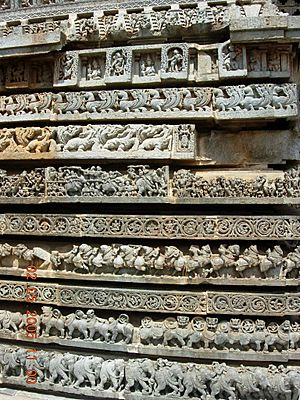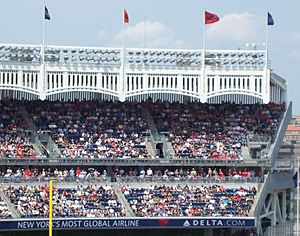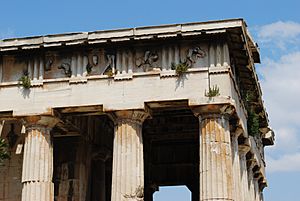Frieze facts for kids



A frieze is a special part of a building or a room. In architecture, it's a wide, flat section that often has cool designs. You can find friezes on many old buildings, especially those from ancient Greece and Rome. The most famous one is probably the Parthenon Frieze.
Imagine a building's top part, called the entablature. The frieze is the middle section of this entablature. It can be plain, or it can be decorated with bas-reliefs. Bas-reliefs are sculptures that stick out only a little from the surface.
Even on walls without columns, the frieze sits above the main beam, called the architrave. It is topped by decorative edges, known as the cornice.
Inside buildings, a frieze is the part of the wall just below the ceiling. It's usually above where pictures hang. These indoor friezes can be made of plasterwork or carved wood. They often have long stretches of painted, sculpted, or even calligraphic art. These decorations are usually above eye-level. Sometimes, friezes tell a story through a series of connected pictures.
For example, the octagonal Tower of the Winds in the Roman agora in Athens has sculptures of the eight winds on its frieze.
Contents
Ancient Friezes Around the World
Friezes have been used in many different cultures throughout history. They often show important stories, symbols, or patterns.
Friezes in Ancient Persia
Ancient Persian buildings, like those at Persepolis, featured detailed friezes. These designs often included repeating patterns and figures. They show the rich art and culture of the Achaemenid Empire.
-
Achaemenid frieze designs at Persepolis.
Friezes in Ancient Greece
Greek friezes are very famous for their beauty and detail. They often show scenes from myths, battles, or religious ceremonies. The Parthenon Frieze is a great example, showing a procession of people and gods.
Friezes in Ancient India
Ancient Indian temples and structures also have amazing friezes. These often feature animals, plants, and scenes from religious stories. They are known for their detailed carvings and symbolic meanings.
Images for kids
See also
 In Spanish: Friso para niños
In Spanish: Friso para niños







